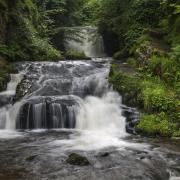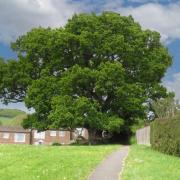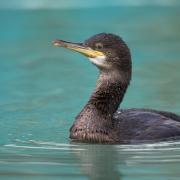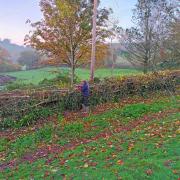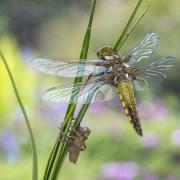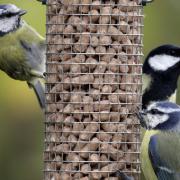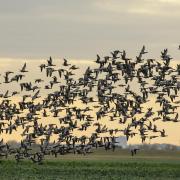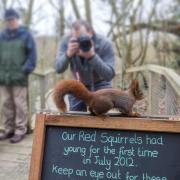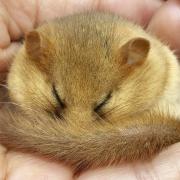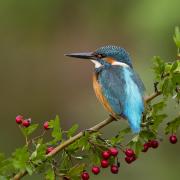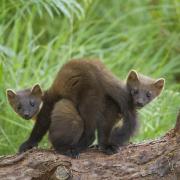In Devon we have three species of thrush which are resident all year round, but this number is boosted in autumn by the inward migration of another two species, David Chapman says this makes it the best time of year to get out and see this group o...
The thrushes which visit us for the winter are called the redwing and fieldfare (collectively known as 'winter thrushes') whilst our resident trio are the song thrush, mistle thrush and blackbird. The term 'resident' in this instance is only partly true. Our own breeding population is fairly sedentary since birds born in Devon have no need to move south in winter. However, that doesn't mean that the populations of these species are static. During autumn we see an increase in the number of blackbirds, in particular, and also song thrushes, with additional birds coming mostly from the north and east, from Scandinavia and Germany, but also some from France where it is also colder.
This movement of birds is partly driven by temperature - the colder the weather the more birds we are likely to see. Cold weather in autumn is often tied in with an anticyclone over Scandinavia, bringing easterly winds to Britain which encourage these migrant birds in our direction. Blackbirds and song thrushes can get caught up in the massive movement of winter thrushes.
The climate in Devon is much kinder to these birds but they must also be able to find food here. Their diets comprise two distinct types of food - berries from the hedgerows and invertebrates from the fields. In a good year it is obvious that our hedges are bursting with the berries of rowan, hawthorn, holly and ivy, which come into season in roughly that order. Our small fields and good hedges are ideal for these birds to find food. When it comes to feeding on the ground, the thrushes like short grass in which to probe for worms and insect larvae such as leatherjackets (the larvae of the crane flies). Unlike in their native lands where the ground will be frozen for long periods, these winter thrushes will always be able to probe the soft, damp ground of Devon.
Thrushes are characterised by a speckled breast and rather plump body, though there is actually quite a wide range of features.
The blackbird (Turdus merula) is the species which looks least like a thrush though it is possible in the female to make out a slightly speckled breast, and both male and female are certainly plump-breasted. The male is almost black with orange bill and legs, whilst the female is brown; at this time of year look out for young males who are black but have a dark bill.
Blackbirds are common in gardens as well as woodland and hedgerow. They are fairly approachable and occur individually or in pairs. They feed on a variety of fruits including hedgerow berries as well as fallen apples, but also take worms and larvae from lawns and other areas of short grassland. Unlike the winter thrushes, it is common to see blackbirds feeding from bird tables; they will take a variety of scraps as well as seed, mealworms and dried fruit.
The song of the blackbird is quite fluty and can be similar to the song thrush, but one sure way of telling them apart is to listen for the repetition which is always present in the notes of the song thrush.
The song thrush (Turdus philomelos) is the archetypal thrush. It has a 'proper' speckled breast and fairly upright stance, its slightly portly physique is positively slim when compared to the blackbird. This is very much a garden bird though it was once much more common in other habitats. Male and female song thrushes are similar; they are a warm-brown colour with cream-coloured underparts and brown spots.
Song thrushes are typically found hopping around on the lawn, where they look for worms and banded snails. They will take fruit but have a less varied diet than the blackbird. It is rare to see more than two song thrushes in close proximity and it is very rare to see one far from the safety of a hedge. For this reason it is unusual to have a good look at a song thrush in flight, something that can't be said of the last of our resident thrushes, however.
The mistle thrush (Turdus viscivorus) is the largest of these three thrushes and has a very upright stance. The least portly of the birds mentioned so far, unlike the other two it is often seen in open grassland. This can be quite an obvious bird in flight because it flies across large expanses of land and tends to make a lot of noise when doing so! The call of the mistle thrush is something like a football rattle and its flight path is distinctly undulating, a little like a woodpecker. If you look closely at a mistle thrush in flight you will notice that it has bright-white armpits which set it apart from the warmer-toned yellow of the song thrush.
Apart from being bigger than the song thrush, the mistle thrush is also greyer and has darker, bolder spotting on its breast, but it is often easier to identify by its call, its behaviour and its habitat. Mistle thrushes are less common in gardens because they tend to shun smaller spaces, their favourite habitat is parkland, a mixture of open grassland and a scattering of mature trees.
The mistle thrush was named because of its habit of eating mistletoe. In fact, its scientific name literally means 'thrush that devours mistletoe', Viscum album being the scientific name for mistletoe. In Devon, where mistletoe is scarce, the mistle thrush was once known as the 'holm thrush', the word 'holm' being derived from the same source as the word 'holly', so in Devon the mistle thrush is the thrush that devours holly berries! Another alternative name for the mistle thrush is the 'storm cock', a name that came about because of this thrush's habit of sitting at the tops of trees to sing, even in stormy weather.
Generally, our three resident species of thrush occur either singly or in small groups whilst the two winter thrushes occur in large flocks. Of these two species, the redwing (Turdus iliacus) is much the smaller, being about the same size as the song thrush. The redwing was named because of a russet-red armpit, fortunately this colouring extends slightly onto its flanks and can be seen when the wings are folded. Probably a more obvious plumage feature of this bird is in the contrast on the bird's head; here there is a mixture of dark-brown plumage and creamy-white lines over and below the eye, which is surprisingly noticeable even from a distance. It is similar in its markings to the song thrush, but the spotting on its breast, as well as the plumage on its back, are both much darker.
The other winter thrush, known as the fieldfare (Turdus piliaris), is much larger. This bird is about the size of the mistle thrush. This really is an unmistakable bird, being quite different in plumage from the other thrushes. It has a creamy belly with heavy spotting but its breast is suffused with brown and its spots are like big arrowheads. The wings of a fieldfare are gingery-brown, quite different from the other thrushes, but probably its most obvious features are its rump and head which are both pale grey.
As well as occurring in large flocks, both the redwing and fieldfare are extremely vocal and wary. They are always on the lookout for danger and will take to the air en masse amidst a series of loud 'chack-chack' calls. In November, when there are still berries to be found on rowan and hawthorn trees, Dartmoor and Exmoor can be particularly productive for these species. As the winter progresses they will find their way to lower levels, commonly feeding in hedgerows around farmland, but they still tend to shy away from heavily populated areas.
We have until March to see this great variety of thrushes before the redwings and fieldfares depart and leave our breeding birds behind;



